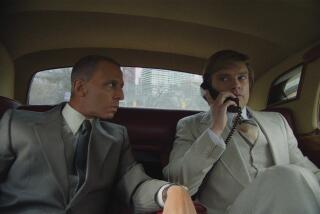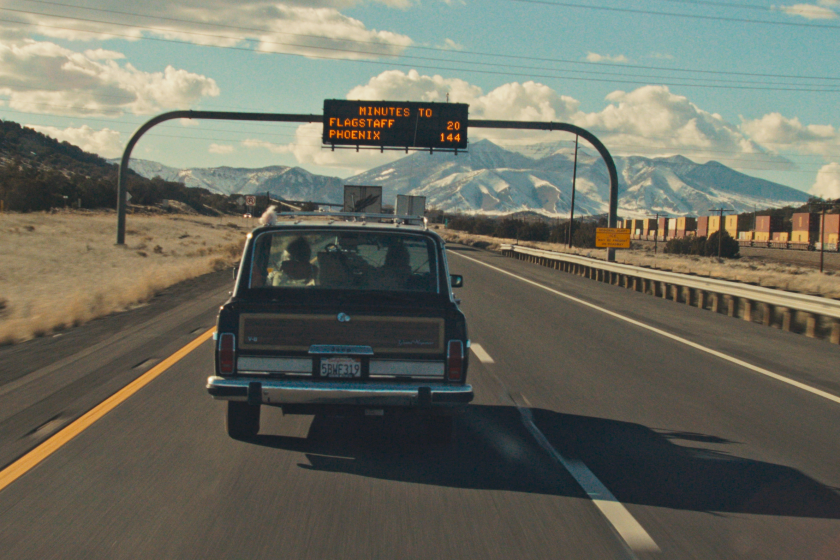Entering the Oscar Race Via Magic and Realism : Movies: Emir Kusturica has only three films under his belt but he is a contender for an Academy Award nomination.
With only three feature films behind him, Yugoslavia’s Emir Kusturica has become one of the most critically acclaimed, award-winning directors in the world.
His first film, “Do You Remember Dolly Bell?” a quirky coming-of-age love story set in Sarajevo’s Muslim community, won the Golden Lion at Venice in 1981. His second, “When Father Was Away on Business,” an evocation of the bleak, paranoid Stalinist era tempered with warmth and humor, won the grand prize at Cannes in 1985. His newest film, “Time of the Gypsies” (opening today at the AMC Century 14), is a strong contender for the foreign-language Oscar nomination.
For all their individuality and clear sense of a fresh, distinctive vision, neither of Kusturica’s first two films prepares you for the impact of the third, with its blend of fantasy, humor, tragedy and even documentary-like qualities. Kusturica admits that he wasn’t sure he could pull off his odyssey of a teen-age Gypsy living in Skoplje’s Gypsy ghetto, which has a population of 50,000 and represents one of the largest concentrations of Gypsies in the world.
“In the middle of shooting, I became very frightened when I realized I was doing both Bunuel and John Ford--and Bunuel and John Ford cannot go together!,” he said, in an interview at his hotel suite.
Yet they do, in a dazzling synthesis derived from Kusturica’s quite-conscious use of the kind of magic realism of such South American writers as Gabriel Garcia Marquez.
The idea for “Time of the Gypsies” came from a newspaper article about some Gypsies selling children in Western Europe. Kusturica’s naive young hero, played by the remarkable young Davor Dujmovic (who was also one of the sons in “When Father Was Away on Business”), is beguiled by a middle-aged, modern-day Fagin engaged in that highly illegal activity.
Another inspiration was a newspaper photo of a Gypsy returning to Yugoslavia from France.
“He was driving some kind of French car, a Peugeot maybe, and on top of it was a 14th-Century table--I really think it was authentic--and some very modern chairs. He looked like a cowboy, with a 10-gallon hat and a plaid shirt. All these different details started me thinking about a movie, and I asked Gordan Mihic (a top Yugoslav screen writer) to work with me.
“The question was how to build up a completely new dimension for the film,” Kusturica said. “We decided that the Gypsies’ historical background should be expressed through their dreams and imagination. The film got richer and richer because it was built from the inside. Then we had the script translated into Romany. This is a nice thing: It’s a foreign film everywhere in the world, including Yugoslavia!”
Early on, Kusturica realized that much of the film would have to be improvised to accommodate the spontaneous temperament of the large cast, 80% of which is composed of Gypsy non-professionals.
“You ask a Gypsy to say one line and he comes up with 100. The Gypsies have such great imagination. They can devise 100 tales while talking to you. . . . There are no rules in their storytelling, and that’s what’s nice.”
Kusturica, who moved into the Skoplje ghetto, as did the few professional, non-Gypsy actors in the cast, had a grueling nine-month shooting schedule, with locations all over Yugoslavia, Milan and Rome.
“The Gypsies brought so much with them to the film,” he said. “I was just selecting, trying to get the positive signals. . . . By the end of the shooting, I was looking like a Gypsy myself! Their first consideration is always how to be happy, not how to have something. How not to be judging people, but trying to understand them, was what was most important to me.”
The tousle-haired, 34-year-old Kusturica attended the FAMU film school in Prague because his aunt was living there with a Yugoslav newspaper correspondent. Since the fall of 1988, he has been teaching film directing at Columbia. He feels that teaching has been not only a good way for him to master English but also to become acquainted with America and our culture.
“At first, it was very hard to understand the students. They all seemed to speak a crazy kind of slang,” he said. “They help me to keep fresh, and I learn so much from them. I don’t understand these Europeans who think they can just come here and do a picture right away.”
“Time of the Gypsies” was a project of David Puttnam at Columbia, and Kusturica feels that his film wouldn’t have been made by the studio if he hadn’t actually been in production--by three days--when Puttnam resigned. One of his next two projects, both of which will be in English, will be with Puttnam.
“It’s ‘Cloves and Cinnamon’ by the Brazilian writer Jorge Amado and is to be shot in Puerto Rico. The story is set on an island before and during World War II. It might be a love story mixed up with totalitarianism. The other film, for Penta Pictures, will be ‘Crime and Punishment’ set in Brighton Beach, which has a large Russian emigre community. I like mixing two languages, two cultures. Then I’d like to do a comedy, finally.”
Kusturica, whose wife and two children have been with him in New York, is uncertain whether he’ll ever work in Yugoslavia again. “I never want to do a film just because it has a ‘nice’ script. Making films is the most important thing in my life, but I don’t see myself making too many of them. Puttnam is the paradigm; with him you can do what you want. I appreciate the studios, but I don’t see myself dealing with them.
“I’m like a Gypsy myself. I like changes. I see myself moving all around for the next 10 years.”
More to Read
Only good movies
Get the Indie Focus newsletter, Mark Olsen's weekly guide to the world of cinema.
You may occasionally receive promotional content from the Los Angeles Times.






